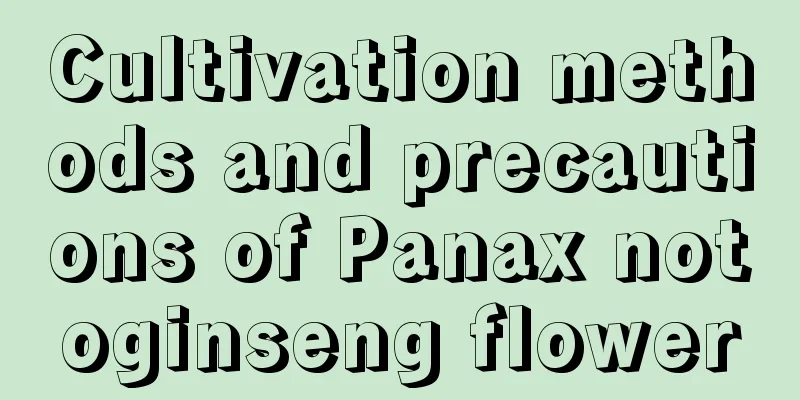Cultivation methods and precautions of Panax notoginseng flower

1. Maintenance methods1. Soil: It grows best in fertile, breathable and well-drained sandy soil, and the soil should be kept moist. You can use sawdust or leaf mold to prepare the soil, but make sure it is kept clean. 2. Light: In summer, you need to block the sunlight to avoid being exposed to the scorching sun. It can accept oblique, scattered and slow light, but cannot accept strong light. 3. Temperature: It will grow better in an environment of 18-25℃, and should not exceed 35℃ in summer. Try to keep the temperature above 5℃ in winter to ensure it survives the winter smoothly. 4. Water: In spring and summer, you need to water it two or three times a month. During the wintering period, the watering frequency must be reduced or even stopped altogether. 2. Breeding techniques1. Sowing: Sowing can be done in October and November every year. Place the seeds evenly in the soil and water them. Make sure the temperature remains around 20°C to ensure the survival of the seeds. 2. Summer: The temperature in summer should be below 35℃, at which temperature breeding can be carried out. Please note that in summer you need to shade yourself from the sun and replenish water in time. 3. Problem diagnosis and treatment1. Damping-off disease: Brown and dry growth occurs when the seedlings are young. Once discovered, timely prevention and treatment is required. Bordeaux mixture or fungicides such as dichlorodiphenyltrichloroethane can be used alternately for spraying, and the diseased plants should be pulled out in time and burned quickly. 2. Black spot disease: Brown spots will appear on its stems, leaves, flowers and fruits. The diseased leaves or branches need to be cut off as soon as possible, and the timely use of polysaccharides can effectively kill the black spot disease. IV. Other issues1. Is it toxic? The information shows that it is non-toxic, so there is no need to worry about toxicity during the breeding process. 2. Can it be grown at home: It can be used as a potted plant at home. It is recommended to grow it in a place with good indoor lighting conditions and ventilate it frequently. It can be placed on an outdoor terrace or in the courtyard at home. It is very convenient and easy to take care of and can be enjoyed. |
<<: Basil seed cultivation methods and precautions
>>: Stevia cultivation methods and precautions
Recommend
Cultivation method of double-petaled plum
1. Soil When planting double-petaled plum, loose,...
What to do if the money tree in the office withers and does not grow (why does it not grow new leaves)
If you master the growth habits of the money tree...
Why are the leaves of lilies turning yellow?
1. Too much watering Reason: Lilies do not like a...
Causes and treatments for yellowing leaves of azalea
1. Soil is too alkaline 1. Reason: Azalea is a fl...
Does honeysuckle like water or drought?
Does honeysuckle like moisture or drought? Honeys...
Management of the flowering period of Rhododendron
Placement This flower prefers a warm location, bu...
Clivia Price
1. Price Compared with other flowers, Clivia is r...
How to cultivate Zhizhihua
Growth conditions of chrysanthemum Zhizhihua, als...
Why are the leaves of water lilies turning yellow?
Bowl lotus is a kind of flower that many people l...
The efficacy and function of kapok bark
The bark of the kapok tree is used as medicine in...
Pest control of asparagus fern
Scale insects Introduction: This is a very common...
How often should I water the big lucky tree?
How often should I water the big lucky tree? The ...
The lowest temperature for Venus flytrap, how to keep it alive in winter
1. Minimum temperature In the winter of the Venus...
How to grow succulent plants
Succulent plants are also known as "lazy pla...
How often should hydrangeas be watered? The correct way to water them
How often should you water your hydrangea? The fr...









